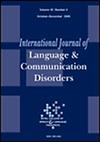The core components of clinical planning for Comprehensive, High-dose Aphasia Treatment (CHAT): A task analysis
Abstract
Background
Intensive comprehensive aphasia programmes (ICAPs) deliver intensive aphasia rehabilitation via a cohort approach, aligning with the World Health Organization's (WHO) International Classification for Functioning, Disability and Health (ICF). ICAPs are an effective treatment approach for aphasia rehabilitation, and their implementation within healthcare settings is currently being investigated. However, there are challenges associated with selecting and tailoring evidence-based treatments for delivery within ICAPs and supportive processes for selecting and tailoring therapy are required. To address this challenge, structured and collaborative clinical planning has been incorporated as a key element of one modified ICAP (mICAP), the Comprehensive, High-dose Aphasia Treatment (CHAT) programme. CHAT provides 50 h of personalized, goal-directed therapy for language impairment and function across 8 weeks. Our current understanding of how clinical planning is conducted for this programme is limited.
Aims
(1) To identify and define the individual tasks performed as part of a structured, collaborative clinical planning process for CHAT and its telerehabilitation counterpart TeleCHAT; and (2) to understand speech pathologists’ perspectives of the key components, roles and resources for clinical planning.
Methods
A mixed methods hierarchical task analysis (HTA) approach was utilized to analyse observations of 10 goal-setting sessions and planning discussions of 13 patients across two CHAT and TeleCHAT cohorts. Focus groups and interviews with seven speech pathologists and two speech pathology leaders involved in delivering or supporting the delivery of the programmes were also conducted. Clinical planning tasks, personnel involved and resources used were iteratively built into a task analysis framework. Perspectives on the key elements of clinical planning were obtained and analysed using deductive qualitative content analysis.
Results
Seven clinical planning tasks, comprising 25 subtasks, were identified across CHAT and TeleCHAT: assessment and analysis, goal-setting, an initial planning meeting, scheduling and coordination, resource preparation, a midway planning meeting, and planning throughout therapy. One additional task was identified for TeleCHAT: identify and prepare technology. Identifying appropriate patients for CHAT and TeleCHAT was considered a precursor to clinical planning. Each clinical planning task was perceived as essential for its success. The involvement of both clinical and research teams and access to resources to structure clinical planning tasks were also described as key elements.
Conclusion/implications
Clinical planning is a central component of CHAT and TeleCHAT, involving a number of multifaceted processes. Understanding how clinical planning is executed in practice is the first step towards implementing ICAPs and mICAPs such as CHAT and TeleCHAT in other settings. Understanding the factors that influence the implementation of the clinical planning process is needed to further inform this translation.
WHAT THIS PAPER ADDS
What is already known on the subject
- Speech pathologists experience challenges selecting and tailoring evidence-based aphasia therapy, and support for clinical planning has been reported to facilitate the delivery of ICAPs.
What this paper adds to the existing knowledge
- This study comprehensively describes the process of clinical planning for the CHAT and TeleCHAT programmes, two Australian-modified ICAPs (mICAPS), and is amongst a few descriptions of treatment mapping processes in broader aphasia rehabilitation practice.
What are the potential or actual clinical implications of this work?
- The detailed description of clinical planning processes, in addition to key resources and personnel for CHAT and TeleCHAT, may assist speech pathology teams in improving clinical planning practices. It is a key preliminary step in translating structured, collaborative clinical planning processes into aphasia rehabilitation practice.


 求助内容:
求助内容: 应助结果提醒方式:
应助结果提醒方式:


